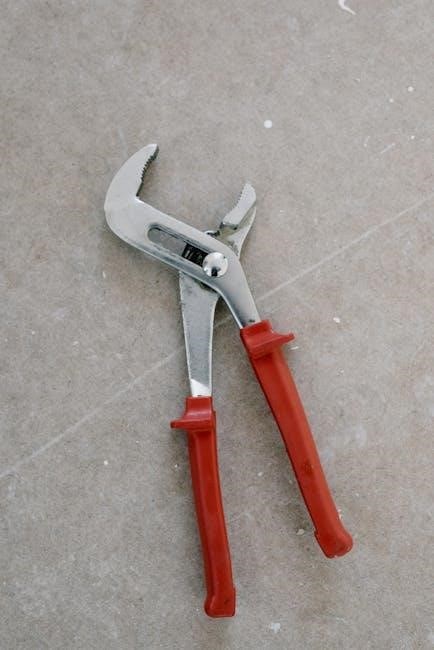Manual Material Handling Equipment (MMHE) includes tools like hand trucks, dollies, pallet jacks, and manual lift tables, designed to assist in moving and storing materials efficiently and safely.
Definition and Importance
Manual Material Handling Equipment (MMHE) refers to tools and devices that rely on human effort to move, lift, or store materials. These tools are essential in industries like manufacturing, warehousing, and logistics, as they enhance efficiency, reduce workplace injuries, and lower operational costs. By minimizing manual labor, MMHE plays a crucial role in optimizing workflows and ensuring safe handling of goods, making it indispensable for modern industrial operations.
Historical Context
Manual material handling equipment has its roots in ancient times, with early civilizations using simple tools like levers and pulleys to move goods. The industrial revolution accelerated its development, introducing hand trucks and dollies to streamline workflows. Over time, these tools evolved to include pallet jacks and lift tables, reducing manual labor and injuries; This equipment has remained essential, bridging the gap between basic manual labor and mechanized solutions, ensuring efficient material movement across industries.

Types of Manual Material Handling Equipment
Common examples include hand trucks, dollies, pallet jacks, and portable conveyor rollers, each designed for specific tasks to enhance efficiency and reduce manual effort in various industries.
Hand Trucks
Hand trucks, also known as sack trucks, are one of the most common and versatile manual material handling tools. They are designed to transport heavy loads efficiently, reducing manual labor and the risk of injury. Available in various types, such as standard, convertible, stair climbers, and heavy-duty models, hand trucks are ideal for moving items like boxes, furniture, and equipment. Their portability and cost-effectiveness make them essential in industries like manufacturing, warehousing, and logistics, where smaller-scale material handling is required.
Dollies
Dollies are essential manual handling tools used to transport heavy or bulky items with minimal effort. They typically consist of a flat platform mounted on wheels or casters, allowing for easy maneuverability. Dollies are versatile and can handle various loads, from small packages to large appliances. They are widely used in manufacturing, logistics, and warehouse settings, helping to reduce strain on workers by minimizing manual lifting and promoting efficient material movement and storage. Their simplicity and durability make them a crucial asset.
Pallet Jacks
Pallet jacks are versatile tools designed to efficiently move and maneuver palletized goods. They consist of a metal frame with a lifting mechanism, enabling users to raise and lower pallets with minimal effort. Available in both manual and motorized versions, pallet jacks are ideal for warehouses, manufacturing facilities, and logistics operations. Their compact design allows easy navigation in tight spaces, making them a cost-effective solution for handling heavy loads safely and efficiently. Regular maintenance ensures optimal performance and longevity.
Manual Lift Tables
Manual lift tables are essential tools for safely raising and lowering heavy loads, reducing strain on workers. These tables are typically operated using foot pedals or hand cranks, allowing precise control over the height adjustment. They are widely used in workshops, warehouses, and assembly lines to optimize workflow and minimize manual lifting. Durable and versatile, manual lift tables enhance productivity while promoting workplace safety by eliminating the need for manual lifting of heavy materials and equipment. Regular maintenance ensures smooth operation and longevity.
Portable Conveyor Rollers
Portable conveyor rollers are versatile tools used to transport materials across short distances manually. These rollers are lightweight, easy to set up, and ideal for moving items in confined spaces where larger conveyor systems are impractical. Often used in warehouses, manufacturing, and logistics, they simplify the process of transferring goods between workstations or storage areas. Their portability and ease of use make them a practical solution for small-scale material handling needs without requiring automation.

Applications Across Industries
Manual material handling equipment is widely used in manufacturing, warehousing, logistics, and transportation to efficiently move and store goods, ensuring smooth operations and safety in diverse industrial settings.
Manufacturing
In manufacturing, manual material handling equipment such as hand trucks and pallet jacks are essential for moving raw materials and finished goods. These tools enhance efficiency by allowing workers to transport heavy loads safely and quickly across the production floor. Additionally, portable conveyor rollers and manual lift tables are used to streamline assembly lines and reduce manual labor, ensuring optimal productivity and minimizing workplace injuries. This equipment is crucial for maintaining workflow and meeting production demands.
Warehousing
In warehousing, manual material handling equipment like dollies and portable conveyor rollers are invaluable for efficiently moving goods. These tools enable workers to transport items across vast storage spaces without heavy machinery, ensuring flexibility. Manual lift tables also assist in safely elevating loads to storage heights, reducing strain on employees. Such equipment is essential for streamlining operations, enhancing productivity, and maintaining organization within the warehouse environment, particularly in areas like receiving, storage, and inventory management.
Logistics and Transportation
In logistics and transportation, manual material handling equipment such as hand trucks and dollies play a crucial role in efficiently loading and unloading goods. These tools are essential for maneuvering items in tight spaces, ensuring smooth operations during transit. Additionally, pallet jacks are frequently used to transport heavy palletized goods across docking areas. Their portability and ease of use make them indispensable in maintaining workflow efficiency and reducing manual labor strain in fast-paced logistics environments.

Advantages of Manual Material Handling Equipment
Manual material handling equipment offers cost-effectiveness, flexibility, and ease of maintenance, making it a practical choice for various industries. These tools are often portable and require minimal setup.

Cost-Effectiveness
Manual material handling equipment is a cost-effective solution for businesses, reducing both upfront and operational expenses. Tools like hand trucks and dollies are affordable and require minimal maintenance. This makes them ideal for small to medium-sized operations, avoiding the high costs of automated systems. Their simplicity ensures long-term savings, making them a practical choice for industries seeking budget-friendly options without compromising efficiency.
Flexibility and Portability
Manual material handling equipment offers exceptional flexibility and portability, allowing easy use in various settings. Tools like hand trucks and pallet jacks are lightweight and compact, making them simple to maneuver in tight spaces. Their versatility enables quick adjustments to different tasks, from moving heavy loads to navigating stairs. This adaptability makes them indispensable in dynamic work environments, ensuring efficient operations without the need for complex setups or infrastructure changes.
Ease of Maintenance
Manual material handling equipment is designed for ease of maintenance, ensuring longevity and reliable performance. Tools like hand trucks and dollies require minimal upkeep, often involving simple cleaning and lubrication of moving parts. Their durable construction reduces the need for frequent repairs, while pallet jacks and lift tables feature straightforward designs that make maintenance accessible and cost-effective. This simplicity ensures equipment remains operational with minimal downtime, supporting smooth workflow in various industries.

Safety Considerations
Proper use of manual material handling equipment minimizes workplace injuries. Tools like hand trucks and pallet jacks reduce strain, while training ensures safe handling practices.
Common Hazards
Manual material handling equipment exposes workers to risks like musculoskeletal injuries from improper lifting and repetitive strain. Malfunctioning tools, such as faulty hand trucks, can cause accidents. Overloading pallet jacks leads to instability, increasing the likelihood of collisions. Lack of training compounds these risks, highlighting the need for proper equipment maintenance and worker education to ensure safe operations and prevent workplace incidents.
Best Practices
To ensure safe and efficient use of manual material handling equipment, always assess the workload and use the right tool for the task. Train employees on proper lifting techniques and equipment operation. Regularly inspect tools like hand trucks and pallet jacks for damage. Encourage proper posture and balanced loads to minimize strain. Maintain a clean workspace to prevent tripping hazards. Finally, enforce adherence to safety guidelines and regulatory standards to reduce injury risks and optimize productivity.
Regulatory Compliance
Compliance with safety standards is crucial when using manual material handling equipment. Regulations like OSHA and ISO standards ensure equipment safety and proper usage. Employers must conduct regular inspections of tools such as hand trucks and pallet jacks to meet these standards. Training employees on equipment operation and safety protocols is mandatory. Adherence to these regulations not only prevents legal penalties but also enhances workplace safety and efficiency, reducing the risk of accidents and ensuring long-term operational reliability.

Future Trends
The future of manual material handling equipment involves automation integration, smart technologies, and sustainable designs, enhancing efficiency while reducing environmental impact and improving worker safety standards globally.
Automation Integration
The integration of automation into manual material handling equipment is transforming industries by enhancing efficiency and reducing manual labor. For instance, robotic delivery systems and autonomous mobile robots (AMRs) are being used to streamline warehouse operations, while motorized pallet jacks and electric lift tables minimize human effort. These technologies not only improve productivity but also reduce the risk of workplace injuries, making them a key focus for future advancements in material handling.
Technological Innovations
Technological advancements are revolutionizing manual material handling equipment, enhancing efficiency and safety. Innovations like AI-powered conveyor systems optimize material flow, while sensor-equipped lift tables reduce strain on workers. Additionally, mobile apps now enable real-time inventory tracking and equipment monitoring. These technologies not only improve operational performance but also reduce the physical demands of manual handling, paving the way for smarter and more sustainable solutions in various industries.
Sustainability Initiatives
Sustainability initiatives in manual material handling focus on eco-friendly equipment designs and practices. For example, hand trucks and dollies made from recycled materials reduce environmental impact. Additionally, pallet jacks with energy-efficient mechanisms minimize resource consumption. These innovations align with global efforts to promote greener supply chains and reduce carbon footprints, ensuring that material handling operations become more environmentally responsible while maintaining productivity.
